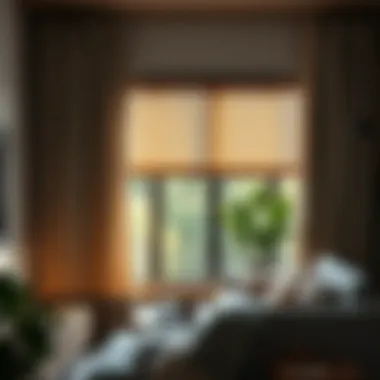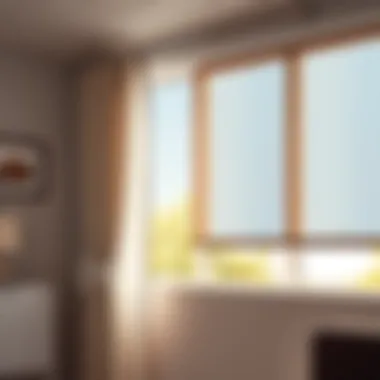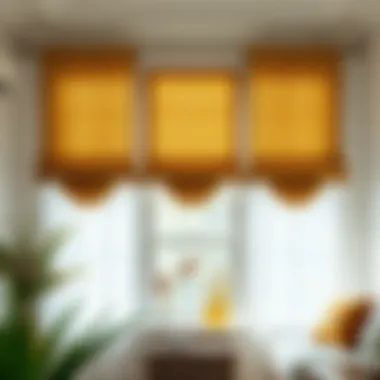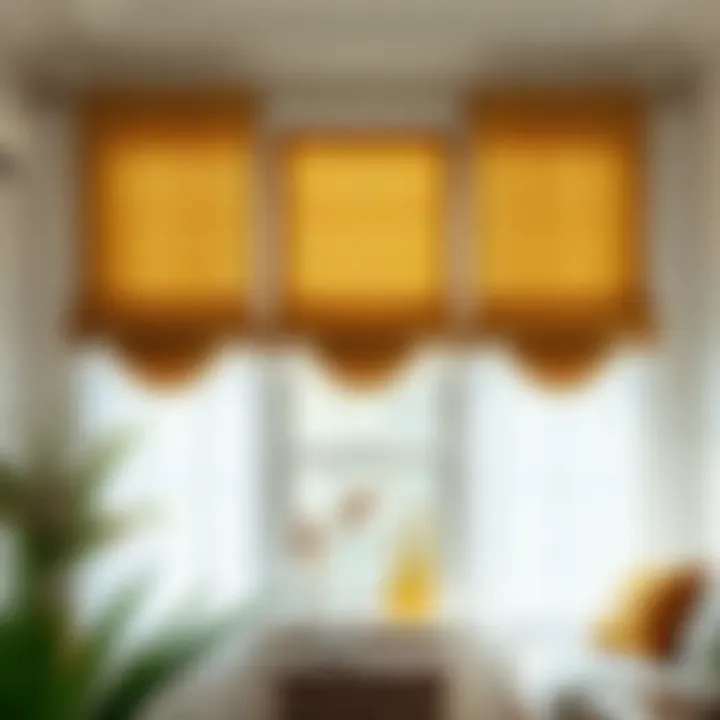Combining Curtains and Blinds: A Complete Guide


Intro
When it comes to home decor, the combination of curtains and blinds can transform a living space. Yet, navigating the integration of these two elements can feel like assembling an intricate puzzle. This guide aims to simplify that process, making it accessible for homeowners, design enthusiasts, or anyone looking to refine their surroundings. The interplay of light and fabric not only enhances aesthetics but also contributes to comfort and functionality. This article walks you through the essential steps, materials you’ll need, and even offers inspiring design tips to create a cohesive window treatment.
Design Inspirations
Trending Styles
Understanding current trends in curtain and blind integration is key to achieving a contemporary look. Some of the most sought-after styles include:
- Layered Looks: Mixing sheer blackout curtains with wooden blinds provides depth and versatility. The sheer layer softens the light while offering privacy, and the blinds give you more control with a robust finish.
- Minimalist Approaches: For a clean, modern aesthetic, consider using simple Roman shades paired with tailored curtains. This setup often features muted color schemes, giving a serene vibe.
- Eclectic Arrangements: Combining bold-patterned curtains with solid blinds can inject personality into a room. Don’t shy away from pairing contrasting textures and hues for a unique touch.
These styling choices not only reflect taste but also influence how natural light enters a space. Each integration can create a distinct atmosphere, making it crucial to choose what resonates with your design sensibilities.
Color Palettes
The color palette you select should echo the mood you want to convey in your home. Here are a few combinations to consider when pairing curtains and blinds:
- Warm Neutrals: Earthy tones like beige, taupe, and warm greys provide a calming backdrop, allowing soft curtains in cream or light beige to create a cohesive scheme.
- Bold Contrasts: If you’re feeling adventurous, deep blues or rich greens in blinds can pair well with light-colored curtains, creating a striking contrast. This approach can turn a window into a focal point.
- Soft Pastels: Light pastel shades can soften a room’s look and provide a comforting atmosphere. Pair pastel curtains with white blinds for an airy feel.
"Color can dramatically influence your perception of space, so choose wisely!"
Incorporating these color ideas will guide you toward creating a harmonious and visually appealing window treatment.
Maintenance and Upkeep
Seasonal Maintenance Checklist
Maintaining the integrity of your curtains and blinds is essential for longevity. Here’s a seasonal checklist to help keep your window treatments in tip-top shape:
- Spring: Clear dust and dirt build-up. A gentle vacuum with a brush attachment works wonders.
- Summer: Check for faded areas. If blinds take a beating from the sun, consider treatments to block UV rays.
- Fall: Inspect fabric for any signs of wear. Spot clean stains with a suitable solution.
- Winter: Ensure curtain seams haven’t frayed, as they can be prone to wear from heated indoor air.
This routine will help you spot potential issues before they escalate, keeping your décor looking sharp.
Cleaning and Organization Tips
Cleaning doesn’t have to be a chore; with some proper strategies, it can be quite manageable:
- Vacuuming: Regular vacuuming can extend the life of your window treatments. Use a nozzle attachment to pull dust out of both curtains and blinds.
- Spot Cleaning: For most fabric curtains, a lightly damp cloth works well for light stains. Test any cleaner on a hidden area first.
- Rotating Curtains: Regularly switch which curtains are visible. This not only keeps aesthetics fresh but can also minimize wear on any single piece.
Keeping these pieces in good condition will allow you to enjoy their beauty for years to come.
For more information and assistance on selecting curtains and blinds, consider visiting Wikipedia or Britannica.
Taking the time to integrate curtains and blinds effectively will undoubtedly elevate your home's ambiance and functionality. The blend of these window treatments will leave your interiors looking polished and stylish.
Preamble to Window Treatments
When one think of a comfortable home, the importance of effective window treatments cannot be overlooked. They act not just as mere coverings but also as key players in creating the overall ambiance of any space. Curtains and blinds, when paired together, provide a beautiful harmony that enhances not only the look but also the practicality of your interiors.
In this guide, we dive into the details regarding why blinds and curtains should go hand in hand, illuminating the choices that homeowners have when it comes to choosing the right combination.
Importance of Blinds and Curtains
Often dismissed as simple decor items, blinds and curtains serve functional purposes that significantly impact the comfort and energy efficiency of a home. They control light levels and regulate temperature and noise, providing a sanctuary away from the hustle and bustle outside. For those who value privacy, the right choice here is critical; a sheer curtain paired with a blackout blind might just be the ticket for both brightness during the day and seclusion at night.
The choices also reflect personal style. From contemporary sleekness to classic elegance, there’s versatility in every inch of fabric or slat. Different weaves and materials enable a homeowner to reinvent a space – sometimes, all it takes is a fresh fabric or color to transition a room from dull to dazzling!
Functional and Aesthetic Benefits
The marriage of curtains and blinds offers rich rewards:
- Light Control: Adjusting the angle of the blinds while drawing the curtains can modulate the amount of natural light that floods in, allowing for a custom lighting experience.
- Insulation: Properly layered window treatments can help in reducing energy costs by keeping the cold air out in winter and the heat in during summer. Understanding this can lead to significant savings on energy bills.
- Design Flexibility: By combining different materials and patterns, creativity knows no bounds. Striped curtains with solid blinds? Why not? Choose shades that compliment each other for a visually pleasing effect.
- Privacy and Security: In urban settings, privacy is paramount. Layering sheerer curtains with blinds can allow daylight to shine through while keeping prying eyes at bay.
Ultimately, creating a peaceable oasis within the home is easily achieved when one understands the art of blending both functionality and aesthetics in their window treatments. This guide aims to provide insight into this nuanced subject so that homeowners can elevate their living spaces with confidence, armed with knowledge appropriate for both practicality and style.
Understanding Different Types of Blinds
In the world of interior design, blinds play an essential role in how spaces are perceived. While curtains often hog the limelight with their flowing fabrics and vibrant colors, blinds bring a unique utility to the table. They not only serve the fundamental purpose of controlling light and privacy but also offer a distinct aesthetic that can complement or contrast with other window treatments, like curtains. Understanding the different types of blinds available is crucial as it lays the groundwork for successfully integrating them with curtains to create a harmonious look.
Each type of blind comes with its own set of characteristics that dictate how they function and interact with the surrounding decor. This understanding allows homeowners to choose the most suitable options based on their personal needs, preferences, and overall design vision. Let's delve into the major types of blinds and what they can offer to your window treatment strategy.
Vertical Blinds


Vertical blinds are an excellent choice for wide windows or sliding doors, offering both functionality and style. Their design features long slats that can be tilted to control light and privacy effectively. One significant advantage of vertical blinds is their ability to filter sunlight while allowing a view to the outside when fully opened.
These blinds are particularly beneficial in rooms that experience varying light throughout the day, as they can be adjusted easily to accommodate different lighting needs. Additionally, vertical blinds come in an array of fabric options, colors, and patterns, making them highly versatile in terms of decor.
However, one thing to keep in mind is the maintenance aspect. Dust and debris can accumulate on the slats, so a regular cleaning routine will keep them looking sharp. For those who enjoy a minimalist aesthetic but need practicality, vertical blinds can be a superb choice.
Horizontal Blinds
Horizontal blinds are perhaps the most common type you'll come across, known for their simplicity and efficiency. Comprising slats that run horizontally, these blinds allow homeowners to tilt the slats to achieve the desired level of light control and privacy. They are particularly well-suited for smaller windows or even standard-sized windows in any room.
Their versatility extends beyond function. As the slats can be made from materials such as wood, faux wood, or aluminum, they can be tailored to fit a rustic, modern, or traditional decor. Horizontal blinds also offer excellent insulation, helping to keep your home cooler in the summer and warmer in the winter.
However, a downside to horizontal blinds is that they can sometimes feel heavy or imposing in smaller spaces. To balance this, pairing them with lightweight curtains can soften their look and add character to the room.
Roller Blinds
Roller blinds are the silent heroes of window treatments. They offer a clean, streamlined look that works beautifully in minimalist or contemporary spaces. These blinds consist of a single piece of fabric that rolls up and down, making them incredibly easy to operate.
One of the key advantages of roller blinds is the sheer range of options available. From blackout fabrics for bedrooms to light-filtering materials for living areas, homeowners can choose what best suits each room's needs. They also provide a high degree of flexibility in color and pattern selection, ensuring they can complement any curtain fabric chosen.
Since roller blinds do not have slats, they tend to collect less dust than other types, but cleaning still requires attention—especially if you opt for a patterned fabric that may show smudges more easily.
Roman Blinds
Roman blinds bring an element of softness that many other blinds lack. Unlike their harsher counterparts, these consist of fabric that folds up neatly when raised, giving a tailored appearance. Roman blinds can add depth to a room's design while providing functional light control and privacy.
Another benefit is their available fabrics—whether sheer or opaque, there's a style for every taste. This adaptability makes it simple to layer them with curtains to achieve a chic, polished look. One should note, however, that Roman blinds may require more extensive cleaning, especially if you choose a fabric prone to dust accumulation.
They work best in living rooms or bedrooms, where their aesthetic qualities can shine without overwhelming the space. For homes looking to embrace a cozy atmosphere, Roman blinds should not be overlooked.
By diving into the nuances of these various blinds, homeowners can make informed decisions that align with their functional needs and design ambitions. The integration of curtains and blinds can lead to a sophisticated and practical window treatment scheme, enhancing the overall look and feel of any space.
Selecting Appropriate Curtains
Selecting the right curtains is a pivotal step in integrating them with blinds. The curtains not only need to complement the functional aspects of the blinds but also enhance the overall decor of a room. Thoughtful choices in curtain selection can contribute significantly to comfort, style, and even energy efficiency. The right curtain can serve to soften light filtering from the blinds, creating a warm ambiance, while also adding an extra layer of texture and depth to your window treatments. Here, we explore material choices, length and style considerations, and color schemes and patterns that will help you land on the ideal curtain match for your blinds.
Material Choices
When it comes to materials, the options are varied. The fabric you choose can influence how well the curtains work together with blinds. Here are some popular fabric choices:
- Cotton: This is a classic choice that’s easy to wash and maintain. Cotton curtains add a casual look and are often breathable, making them practical for many settings.
- Linen: This offers a more elegant appearance and has a luxurious feel. However, be mindful that linen can wrinkle easily, so it might require more ironing.
- Velvet: Thick and sumptuous, velvet curtains are perfect for adding opulence to a room. They also block out light effectively, making them ideal for bedrooms.
- Synthetics: Polyester or blends are budget-friendly and resistant to fading. They can mimic the appearance of natural fibers while being low maintenance.
Your selection should consider not only the visual appeal but also the functionality you seek. For instance, if you’re looking to block light, heavier fabrics like velvet might be your go-to option.
Length and Style Considerations
Length plays a substantial role in the visual effect of your curtains. Typically, curtains should just kiss the floor but can also puddle for a more dramatic effect. Here’s a breakdown of some common styles:
- Sill Length: These curtains fall just above the window sill, being easy to manage and ideal for kitchens or smaller windows.
- Apron Length: This style ends just below the window apron, offering a clean and crisp look.
- Floor Length: Reaching the floor, these curtains can make a room feel taller and provide an elegant backdrop to furnishings.
- Puddle Length: These styles pool on the floor, creating a romantic and luxurious vibe, but take care with maintenance as they may collect dust.
Color Schemes and Patterns
Color and pattern selection is where your creativity can shine. The drape you choose should enhance or contrast the blinds effectively. Here are some tips:
- Solid Colors: Opting for solids can bring a sense of calm and can pair well with patterned blinds, allowing the blinds to be the focal point.
- Stripes or Geometric Patterns: These can add interest and dimension to a space, especially if either the blinds or curtains are subdued. They can introduce modern lines to traditional decor.
- Florals or Prints: If you're aiming for a more eclectic look, busy prints might be just the ticket. However, consider scale—larger prints often work better on larger windows.
Tip:
It’s often beneficial to take swatches of your fabric choices and patterns against your blinds at different times of the day to see how the light affects the colors and textures.
Taking all these facets into account will enable you to select curtains that beautifully enhance your interior, making the integration with blinds as seamless as possible.
Tools and Materials Needed
When it comes to merging curtains with blinds, having the right tools and materials on hand is as crucial as knowing the methods themselves. This section breaks down the essential items required, helping to ensure that the installation process is as smooth as possible. Not only will this guide you in the right direction, but it might also save you from any unnecessary headaches down the road.
Measuring Tools
Before you kick off any project, measuring tools come into play and play a big role in your success. Accuracy is key when it comes to the aesthetics and functionality of your window treatments. Here’s what you’ll need:
- Measuring Tape: A good old-fashioned measuring tape is non-negotiable. It allows you to get precise width and height measurements of your windows. When in doubt, measure twice, cut once.
- Level: Keeping things straight is vital. Whether you’re hanging rods or blinds, a level will help ensure that everything aligns beautifully. Any tilt can make an otherwise wonderful setup look downright awkward.
- Pencil and Paper: Jotting notes and marking measurements is a must. It’s easy to forget numbers when you're juggling multiple tasks, so make sure to keep a record.
Using accurate measuring tools not only streamlines the process but also enhances the overall look once you're done. A well-measured window treatment sets a solid foundation for elegance and functionality.
Hanging Hardware


Now that you’ve got your measurements sorted out, let’s talk hanging hardware. This speaks to the mechanisms that hold your curtains and blinds in place. The right hardware makes a difference between a sturdy setup and a shaky one.
- Curtain Rods: Choose rods that are suitable for the weight of your curtains. Thicker rods work better for heavier fabrics, while lighter rods can do just fine for sheer curtains. Pay attention to the length as well, as some areas might require extended rods to accommodate both curtains and blinds.
- Brackets and Supports: These are the unsung heroes of your installation. They hold your rods securely. Ensure they are compatible with your chosen rods to avoid any mismatches.
- Blind Mounting Brackets: Depending on your blind type, you will need specific mounting brackets that will allow the blinds to function properly. These come in various styles, so choose according to your blinds' requirements.
Investing in good hanging hardware can save you from future complications; after all, the last thing you want is for your beautifully designed window treatments to come crashing down.
Installation Tools
When you’re ready to install, having the right installation tools at your disposal will keep everything going without a hitch. Don’t skip this step; it can make the difference between a five-minute job or an all-day struggle.
- Drill and Drill Bits: A versatile tool that can handle most of what you need. Make sure you have the right drill bits for wood, drywall, or metal depending on the type of surface you'll be working on.
- Screwdriver: Whether it’s manual or electric, having a screwdriver on hand is essential for attaching both the brackets and the hardware. Choose a type that matches the screws provided.
- Stud Finder: This little gadget can save you a lot of trouble. Knowing where the studs are in your walls means you can install your hardware into something stable.
To ensure your hard work pays off, arm yourself with the right installation tools. You’ll find the process less daunting and more rewarding, which is exactly what you want when transforming your windows into a stylish oasis.
Methods for Attaching Curtains to Blinds
The integration of curtains with blinds is more than just a design choice; it enhances functionality and aesthetics of a room. Understanding the methods for attaching curtains to blinds is crucial in attaining a cohesive and personalized window treatment. Each method offers its own benefits and potential drawbacks, making it essential to consider factors such as ease of use, appearance, and compatibility with the specific blinds or curtains you have.
Using Clip Rings
Clip rings are a straightforward yet effective solution for attaching curtains to blinds. They allow for a quick setup and can be adjusted or removed easily—ideal for those who prefer flexibility. You can choose clip rings that match your existing decor, ensuring that they blend in instead of standing out.
To use clip rings:
- Simply attach the clips to the top edge of the curtains, securing them in place.
- Once ready, slide these clips onto the blind’s headrail or one of the support arms, depending on your blind style.
- The key benefit here is that it allows the curtain to hang freely, providing smooth movement and adding layers to the window.
Be mindful to choose clip rings that can comfortably hold the weight of the fabric you are planning to use. Heavy materials need clip rings that have robust construction to ensure they do not sag or detach over time.
Utilizing Curtain Rods
Another practical method is to utilize curtain rods. This approach is particularly effective when you want to show off the beauty of your curtains while maintaining their functionality. Curtain rods can be mounted above the blinds, allowing for an elegant layering effect. Different styles—such as traditional, contemporary, or rustic—can greatly enhance the overall aesthetic of your space.
For optimal installation:
- Measure the length needed for the curtain rod to ensure it extends beyond the width of the blinds.
- Mount the rod correctly using suitable brackets for stability, either above or alongside the blinds.
- Hang the curtains and adjust for desired draping.
A well-chosen curtain rod can also serve as a decorative element, elevating the entire window treatment. Consider rod styles that complement both your curtains and the surrounding decor.
Implementing Adhesive Velcro
If you're looking for a solution that is no-fuss and versatile, adhesive Velcro can be a game changer. This method allows for a very seamless attachment process. It is particularly effective for lightweight curtains and offers a clean and streamlined look without hardware.
To implement this method:
- Apply strips of adhesive Velcro to the top of the curtains. Make sure to press firmly for a secure bond.
- Adhere the matching Velcro strips directly onto the blinds.
- For best results, align the strips before pressing them together to avoid misalignment.
This method provides an excellent way to create a “floating” effect for the curtains, enhancing the layered look. While it allows for easy adjustments, consider how it may affect your ability to wash and maintain your curtains.
Each of these methods for attaching curtains to blinds has something unique to offer. Choosing the right method depends on personal preference, curtain type, and design aspirations. Homeowners and design enthusiasts should carefully evaluate their needs, preferences, and the dimensions of their window treatments before deciding on the best method.
Step-by-Step Installation Process
In the realm of home improvement, installing window treatments may seem like a task best left to professionals. However, integrating curtains with blinds can be a straightforward project if approached with a structured plan. The step-by-step installation process is crucial in ensuring that your efforts yield both functionality and aesthetic appeal.
By following a clear sequence of actions, you will not only streamline the installation but also minimize the potential for errors and mishaps. This methodical approach allows homeowners, interior design enthusiasts, and even party hosts to confidently enhance their living spaces. Let’s break down this process into manageable steps.
Preparing the Area
Before diving into the actual installation, it’s essential to prepare your space. Clearing the area around the window is the first step. This means removing any furniture or decorations that could obstruct your work. You wouldn’t want to knock over your great-aunt’s vase while trying to hang curtains, right?
Next, take a look at your window and assess the condition of the fixtures already in place:
- Dust and clean the window frame to ensure a good fit for your new setup.
- Check for damage. Look for signs of wear, rot, or water damage, which might need addressing. A well-prepared window frame sets a solid foundation for hanging your treatments.
Using a measuring tape, confirm measurements of both the window and any existing blinds. This information will be key when custom-fitting your curtains. Organize your tools within easy reach, including a drill, level, and any hardware you’ll need for the installation. Remember, a stitch in time saves nine; having everything ready will prevent any unnecessary back-and-forth to the garage!
Attaching the Curtain Hardware
Once the area is ready, it’s time to attach the hardware that holds your curtains. This step is pivotal; if the hardware isn’t secured properly, your curtains won’t hang straight and could even come crashing down.
- Mark the points where the brackets will be attached based on your measurements. Keep it level—your eye may not be the best judge, so it helps to use a level for precision.
- Drill holes carefully, especially if you’re working with drywall or other materials—take care to follow any instructions specific to your hardware.
- Attach the brackets using screws. Ensure each bracket is tightly fastened and can bear the weight of the curtains without sagging. Don’t rush this part; it’s like building a firm house foundation.
- If you plan to hang curtains alongside blinds, now is the time to make any necessary adjustments for clearance. You want to avoid scenarios where the curtains interfere with the smooth operation of your blinds.
Hanging the Curtains
Finally, it’s time for the pièce de résistance: hanging your curtains. With the hardware secured, you can now bring some fabric beauty into your space.


- Feed the curtains through the rod or attach them to the clips if you’re using that method. If you’re using multiple layers, ensure you hang the blinds first, followed by the curtains, which will help create a layered look that adds depth.
- Adjust for symmetry. Step back and look at your work; you want to ensure everything hangs evenly. This is where minor adjustments can go a long way.
- Once everything looks good, take a moment to step back and admire the transformation. Check to see how the curtains fall when you move the blinds; they should complement each other without clashing.
After ensuring all looks shipshape, your new window treatment is not just functional but also enhances the overall vibe of your room. Don’t be surprised if you find yourself sitting by the window more often, simply to enjoy your handiwork!
Remember, mastering the installation process isn’t just about following steps; it’s about taking your time and ensuring that everything fits just right!
By understanding this whole installation process from preparation to the final touch, homeowners can confidently tackle even the most intricate window treatment challenges.
Maintenance and Care for Window Treatments
Taking care of window treatments like curtains and blinds is akin to maintaining a classic car; neglect can lead to a decline in both function and appearance. Regular maintenance not only prolongs the life of these items but also ensures that your living space remains welcoming and stylish. Each treatment serves a unique purpose, but together they work to create an environment that reflects your taste while ensuring energy efficiency. Ignoring the upkeep could lead to premature wear and creates a dreary, unkempt atmosphere.
When considering maintenance, we need to look at two critical aspects: cleaning and repairing common issues. Both contribute to the longevity of the window treatments and can significantly impact how they integrate into your decor.
Cleaning Techniques
Cleaning is the first line of defense against dust, allergens, and grime. Just like a discerning art collector wouldn’t let moths ravage their prized possessions, a homeowner must protect their window dressings.
Here are a few cleaning techniques to consider:
- Dust Regularly: Use a feather duster or a microfiber cloth to wipe down blinds and curtains at least once a week. This practice prevents dust buildup and keeps your space fresh.
- Vacuum with Care: For heavier materials like drapes, a vacuum with an upholstery attachment can make quick work of dirt and pet hair. Just be gentle to avoid dislodging the fabric.
- Spot Clean Stains: For spills or stains that happen due to a spontaneous gathering or a morning coffee mishap, attend to them quickly. Use a damp cloth with mild soap to blot the stain gently. Remember, scrubbing can cause more harm than good.
- Wash as Needed: Curtains, especially those made of lighter fabric, can be washed according to the manufacturer's instructions. When a thorough clean is required, consider a delicate cycle in cold water or hand-washing. Do not forget to line dry to maintain shape.
A side note worth mentioning is that some fabrics are more forgiving than others. Polyester and cotton curtains typically hold up well in a machine wash, while delicate materials like silk should always be handled with care, possibly requiring professional cleaning.
Repairing Common Issues
Even the finest setups may face hiccups over time. The goal is to catch any problems early before they escalate into something requiring major intervention.
Common issues you might encounter include:
- Broken Slats on Blinds: A common sight in homes with busy households. Many blinds come with replacement slats, which can be swapped out to save your blinds from looking ragged.
- Snags or Tears in Curtains: Life happens, and sometimes fabric doesn’t remain pristine. A needle and thread or fabric glue can do wonders if your curtains have small tears.
- Difficult to Operate Blinds: If you've found your blinds sticking or becoming hard to open, it may just require some lubrication on the mechanism. A silicone-based spray can enhance functionality.
"A little bit of maintenance goes a long way, not just for aesthetics but for functionality too."
Adopting regular maintenance habits is a sensible approach that pays off when it comes to keeping your window treatments both looking sharp and functioning smoothly. It’s truly the small efforts that can yield a big difference in the overall aesthetic and comfort of your home.
Enhancing the Look of Combined Treatments
When it comes to window treatments, blending curtains with blinds can elevate the aesthetic of any space. The goal is not just functionality but also creating an inviting atmosphere that reflects your personal style. Enhancing the look of combined treatments allows homeowners and design enthusiasts to explore diverse design elements that speak volumes about their taste while also optimizing the practicality of their interiors.
Layering Techniques
Layering can breathe new life into standard blinds and curtains, transforming a mundane window into a visual delight. It involves arranging various materials and styles in such a way that they complement each other beautifully. For instance, pairing light sheer curtains with heavy blackout blinds can create a dynamic effect while serving the dual purpose of light control and privacy.
- Variations in Length: Try having your curtains extend down to the floor while your blinds sit at a standard window length. This difference often adds depth.
- Texture Play: Use a linen curtain combined with smooth vinyl blinds. The contrast not only captures attention but also adds a tactile experience.
- Style Combinations: Consider combining classic curtains with contemporary roller blinds to achieve a mix of tradition and modernity that showcases your personality.
Layering not only enriches the aesthetics but also gives you the flexibility to modify your room's ambiance, enhancing coziness on chilly days and airiness during summer.
Coordinating Colors and Textures
Color and texture coordination is paramount in achieving a streamlined appearance when integrating curtains with blinds. When done right, it not only ties together the elements in a room but also influences the overall mood.
To make this work, think about the following:
- Harmonious Palettes: Choose a color palette that resonates throughout your space. Soft, muted tones paired with bold accents can create focus areas without overwhelming the senses.
- Textural Contrast: Mix soft fabrics for curtains with the crisp, structured appeal of blinds. This duality invites curiosity and warmth, encouraging a deeper appreciation for your design choices.
- Pattern Balance: If your curtains have intricate patterns, balance them with solid or simple blinds. It’s like giving your eyes a place to rest amid a visual feast; nobody needs a pinball machine in their lounge.
Overall, coordinating colors and textures in this fashion can make your window treatments not just functional but also a stunning feature of your home's design.
"Every room needs a focal point. Why not make it your windows?"
Closure
Integrating curtains with blinds is not just a trend; it’s become a necessity for many homeowners seeking both practicality and flair in their living spaces. The importance of understanding this topic lies in its ability to transform your windows into eye-catching features while also enhancing functionality. By blending curtains and blinds, you can achieve the perfect balance of light control, privacy, and aesthetic appeal.
Recap of Key Points
As we wrap up this guide, let’s revisit the essential elements we've explored:
- Understanding Types: We delved into various blind types such as vertical, horizontal, roller, and Roman blinds, each offering unique benefits that can complement different curtain styles.
- Curtain Selection: Choosing the right fabric, length, and color scheme ensures your window treatments align beautifully with your overall decor.
- Attaching Techniques: Methods like clip rings, curtain rods, and adhesive Velcro allow for versatile combinations, facilitating both ease of use and style.
- Maintenance Tips: Regular cleaning and prompt repairs prolong the life of your window treatments while maintaining their appearance.
- Enhancing Aesthetics: Layering your curtains with blinds can spark dynamic visual interest, creating depth and texture in your rooms.
"A well-dressed window can serve as a centerpiece, elevating the entire room’s ambiance."
By considering these aspects, you set yourself on a path toward creating an inviting atmosphere that reflects your personal taste.
Final Thoughts on Personalization
Personalization is a key takeaway from our exploration. Blank canvases, such as plain walls, can be transformed with the unique touch of tailored window treatments. Selecting colors and patterns that resonate with your personality adds character to a space.
- Think about combining different textures; a linen curtain with bamboo blinds can create an intriguing visual story.
- Don't shy away from experimenting—play with layering; a sheer curtain over dark blinds can give you flexibility in ambiance throughout different times of the day.
- Lighting is crucial; how natural light filters through your selections can drastically affect the mood of the room.
Your choices can reflect your journey and experiences, turning even the most mundane corners of your home into a narrative of comfort and character. Remember, a little creativity goes a long way, turning functional window treatments into artistic statements.







